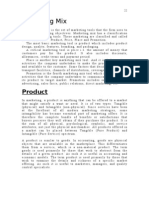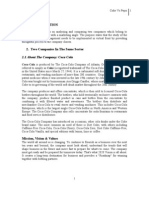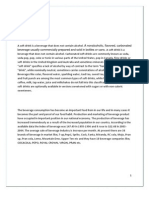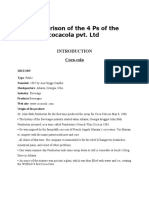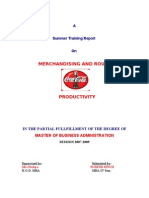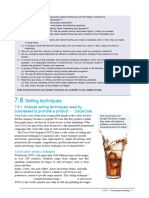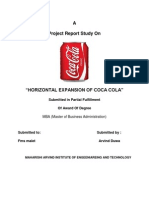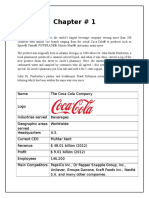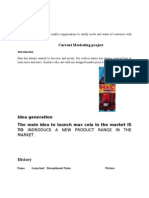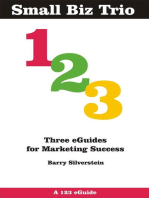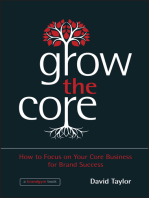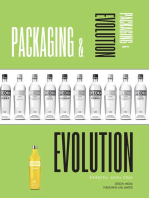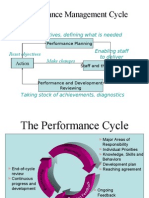Marketing Mix Report
Marketing Mix Report
Uploaded by
rehanrafiq59Copyright:
Available Formats
Marketing Mix Report
Marketing Mix Report
Uploaded by
rehanrafiq59Copyright
Available Formats
Share this document
Did you find this document useful?
Is this content inappropriate?
Copyright:
Available Formats
Marketing Mix Report
Marketing Mix Report
Uploaded by
rehanrafiq59Copyright:
Available Formats
Marketing Mix
Marketing Mix is the set of marketing tools that the firm uses to pursue its marketing objectives. Marketing mix has a classification for these marketing tools. These marketing are classified and called as the Four Ps i.e. Product, Price, Place and Promotion. The most basic marketing tool is product which includes product design, quality, features, branding, and packaging. A critical marketing tool is price i.e. the amount of money that customers pay for the product. It also includes discounts, allowances, credit terms and payment period. Place is another key marketing mix tool. And it includes various activities the company undertakes to make the product accessible and available to the customer. Some factors that decide the place are transport facilities, channels of distribution, coverage area, etc. Promotion is the fourth marketing mix tool which includes all the activities that the company undertakes to communicate and promote its product to target market. Promotion includes sales promotion, advertising, sales force, public relations, direct marketing, etc.
Product
In marketing, a product is anything that can be offered to a market that might satisfy a want or need. It is of two types: Tangible (physical) and Intangible (non-physical). Since services have been at the forefront of all modern marketing strategies, some intangibility has become essential part of marketing offers. It is therefore the complete bundle of benefits or satisfactions that buyers perceive they will obtain if they purchase the product. It is the sum of all physical, psychological, symbolic, and service attributes, not just the physical merchandise. All products offered in a market can be placed between Tangible (Pure Product) and Intangible (Pure Service) spectrum.
A product is similar to goods. In accounting, goods are physical objects that are available in the marketplace. This differentiates them from a service, which is a non-material product. The term goods is used primarily by those that wish to abstract from the details of a given product. As such it is useful in accounting and economic models. The term product is used primarily by those that wish to examine the details and richness of a specific market offering. As such it is useful to marketers, managers, and quality control specialists.
A service is a non-material or intangible product - such as professional consultancy, serving, or an entertainment experience.
Permalink Reply by + M.Tariq Malik + on September 15, 2011 at 10:20pm Coke - Product The Coca-Cola formula is The Coca-Cola Company's secret recipe for Coca-Cola. As a publicity marketing strategy started by Robert W. Woodruff, the company presents the formula as one of the most closely held trade secrets ever and only a few employees know or have access to. This Coca-Cola formula appears to be the original formula to Coca-Cola. It is from the book For God, Country and Coca-Cola.
The company Coca-cola is a multinational and it is not limited to one product. Through the years they have invented and introduced many products than their main cola drinks. The list of Coca-cola brands are as follows:
1. 2. 3. 4. 5. 6. 7. 8. 9.
Appletiser Aquarius BPM Energy Barq's Beat soda Beverly Cannings Cheers Ciel
36. Lemon & Paeroa 37. Lift 38. Lift plus 39. Lilt 40. Manzana Lift 41. Mare Rosso 42. Mello Yello 43. Mezzo Mix 44. Minute Maid 45. Nestea
10. Coca-Cola Black Cherry Vanilla 1. 2. 3. 4. 5. 6. 7. 8. Coca-Cola Blak Coca-Cola C2 Coca-Cola Cherry Coca-Cola Citra Coca-Cola M5 Coca-Cola Zero Coca-Cola Coca-Cola with Lemon 1. Coca-Cola with Lime 2. Dasani 3. Delaware Punch 4. Diet Coke 5. Fanta 6. Fanta Citrus 7. Fioravanti 8. Fresca 9. Frisco 10. Fruitopia 11. Frutonic 12. Full Throttle 13. Georgia 14. Hi-C 15. Hit 16. Kia-Ora 17. Kinley
46. New Coke 47. Nordic Mist 48. OK Soda 49. Pibb Xtra 50. Powerade 51. Qoo 52. Raspberry Coke 53. Relentless 54. Sarsi 55. Senzao 56. Simply Orange 57. Smart 58. Sparkle 59. Sprite 60. Sprite Ice 61. Sprite Remix 62. Sprite Zero 63. Surge 64. Swerve 65. Tab 66. Tab Clear 67. Tab Energy 68. Tab X-Tra 69. Tiky 70. Vault
Permalink Reply by + M.Tariq Malik + on September 15, 2011 at 10:20pm Pepsi - Product
The Pepsi-Cola drink contains basic ingredients found in most other similar drinks including carbonated water, high fructose corn syrup, sugar, colorings, phosphoric acid, caffeine, citric acid and natural flavors. The caffeine free Pepsi-Cola contains the same ingredients but no caffeine. Some of the different and varied brands of Pepsi are as follows:
1. All Sport 2. Aquafina 3. Caffeine-Free Pepsi 4. Crystal Pepsi 5. Diet Pepsi 6. Gatorade 7. Izze 8. Jazz 9. Josta 10. Kas 11. Manzanita Sol 12. Mirinda 13. Mountain Dew 14. Mountain Dew AMP 15. Mountain Dew LiveWire 16. Mountain Dew MDX 17. Mug Root Beer
18. Pepsi 19. Pepsi Blue 20. Pepsi Cappuccino 21. Pepsi Max 22. Pepsi ONE 23. Pepsi Samba 24. Pepsi Tarik 25. Pepsi Twist 26. Propel Fitness Water 27. Sierra Mist 28. Slice 29. SoBe 30. Storm 31. Teem 32. Tropicana Products 33. Tropicana Twister
Permalink Reply by + M.Tariq Malik + on September 15, 2011 at 10:21pm Coke v/s Pepsi-Product As seen above both the companies Coke and Pepsi have a number of products. Many of these products are innovations but there are also many products which are brought out just as a competitive product for the other companies. Some of these products that are brought in the market by both the companies to compete against each other are as follows:
Coke
Pepsi
The main dark cola drink of the company which started the rivalry between these companies. Full Throttle is an energy drink brand produced by The Coca-Cola Company. It debuted in late 2004 in North America.
Pepsi version of dark cola which is the major primary competitor to Coke.
AMP is an energy drink produced and distributed by PepsiCo under the Mountain Dew soft drink brand.
Vault is a carbonated beverage that was released by The Coca-Cola Company in June 2005.
Mountain Dew MDX is an energy drink manufactured and distributed by PepsiCo under the Mountain Dew brand. It was introduced in 2005.
Powerade is a sports drink by The CocaGatorade is a non-carbonated sports drink Cola Company and currently number two in marketed by Quaker Oats Company, a the sports drink market worldwide. division of PepsiCo. Originally made for athletes, it is now often consumed as a snack beverage. Sprite is a clear, lemon-lime flavored, noncaffeinated soft drink, produced by the Coca-Cola Company. It was introduced to 7 Up is a brand of a lemon-lime flavored the United States in 1961. soft drink.
Minute Maid is a product line of beverages, Tropicana Products is an American usually associated with orange juice, but company based in Bradenton, Florida, USA, now extends to soft drinks of many kinds. which is one of the world's largest producers The Minute Maid company is now owned and marketers of orange juice. It has been by Coca-Cola, and is the world's largest owned by PepsiCo, Inc. since 1998. marketer of fruit juices and drinks. It is headquartered in Houston, Texas.
Nestea is a brand of iced tea manufactured Lipton Original Iced Tea is a ready-to-drink and distributed by the Nestle company's iced tea brand sold by Lipton through a beverage department in the United States, worldwide partnership with Pepsi. and by Coca-Cola in several European countries, Brazil and Venezuela. Barq's is a brand of root beer notable for Mug Root Beer is a brand name of root beer being the only major North American root made by the Pepsi company.
beer to contain caffeine. It has been bottled since the start of the 20th century and is currently sold by the Coca-Cola Company.
Diet Coke or Diet Coca-Cola is a sugar-free Diet Pepsi is a low-calorie carbonated cola. soft drink produced and distributed by The It was introduced in 1964 as a variant of Coca-Cola Company. It was introduced in Pepsi-Cola with no sugar. the United States in July 1982.
Kinley is a brand of still or carbonated Aquafina is a non-carbonated bottled water water owned by The Coca-Cola Company. produced by PepsiCo.
Aquarius is a mineral sports drink All Sport was a sports drink. It is produced manufactured by The Coca-Cola Company. by PepsiCo. It was first introduced in 1983.
Fanta is a soft drink brand owned by The Coca-Cola Company. It is produced and distributed by The Coca-Cola Company's bottlers.
Mirinda is a brand of soft drink. Mirinda is owned by PepsiCo.
Sprite Ice was the first flavor extension for Pepsi Blue is a soft drink made by PepsiCo The Coca-Cola Company's Sprite brand soft and launched in mid-2002. drink.
Coca-Cola Blak is a coffee-flavoured soft drink introduced by Coca-Cola in 2006. Pepsi Cappuccino is a cappuccino-flavored carbonated soft drink produced by Pepsico. Slice is a line of fruit-flavored soft drinks manufactured by PepsiCo and introduced in 1984. Teem was a lemon-lime-flavored soft drink produced by The Pepsi-Cola Company.
Maaza is a Coca-Cola fruit drink brand marketed in India and Bangladesh.
Limca is a lemon and lime flavoured carbonated soft drink made in India by Coca-cola.
Permalink Reply by + M.Tariq Malik + on September 15, 2011 at 10:21pm Price In economics and business, the price is the assigned numerical monetary value of a good, service or asset. Price is also central to marketing where it is one of the four variables in the marketing mix that business people use to develop a marketing plan. Pricing is a big part of the marketing mix. Choosing the right price and the right pricing strategy is crucial to the marketing process. The price of the product is not something that is fixed. On the other hand the price of the product depends on many other factors. Some times the price of the product has got nothing to do with the actual product itself. The price may act as a way to attract target customers. The price of the product is decided keeping many things in mind. These things include factors like cost incurred on the product, target market, competitors, consumer buying capacity etc.
Coke - Price
Coke was a company ruling the markets before Pepsi entered. Earlier the price of coke was cost based i.e. it was decided on the cost which was spent on making the product plus the profit and other expenses.
But after the emergence of other companies especially the likes of Pepsi, Coca-cola started with a pricing strategy based on the basis of competition. Nowadays more expenses are spent on advertising my soft-drink companies rather than on manufacturing.
Coke has brought in a revolution especially in Indian markets with the Rs. 5 pricing strategy which was very famous. It was the first company to introduce the small bottle of Coke for just Re.5. This campaign was very successful especially with the price conscious Indian consumers.
Even today most prices of Coke are decided on the basis of the competition in the market.
Pepsi Price
Pepsi again decides it price on the basis of competition. The best think about the company Pepsi is that it is very flexible and it can come down with the price very quickly. The company is renowned to bring the price down even up to half if needed.
But this risk taking attitude has also earned Pepsi losses. Though lowering the price would attract the customers but it would not help them cover up the cost incurred in production hence causing them losses. This was the situation earlier but now Pepsi is a full-fledged and growing company. It has covered all its losses and is now growing at a rapid rate.
Permalink Reply by + M.Tariq Malik + on September 15, 2011 at 10:21pm Place
Place is a term that has a variety of meanings in a dictionary sense, but which is principally used in a geographic sense as a noun to denote location, though in a sense of a location identified with that which is located there.
In marketing, place refers to one of the 4 P's, defined as "the market place". It can mean a geographic location, an industry, a group of people (a segment) to whom a company wants to sell its products or services, such as young professional women (e.g. for selling cosmetics) or middle-aged family men (e.g. for selling family cars).
Coke - Place
Coke is a multinational company and it has its market around the entire world. This can be said just by the first page on its site which asks people to select the place of their choice. The website looks something like this:
Pepsi Place
Pepsi again has spread worldwide. Pepsi when entering a new market does not go in alone but it looks for partners and mergers. Till now Pepsi has collaborated with companies like Quaker Oats, Frito-lays, Lipton, Starbucks, etc.
Pepsi like Coke has spread all over the world. It is because of this worldwide spread that now it is coming up with Advertisements which can be broadcasted in the different nations in the world. The recent example with would be the Pepsi advertisements having David Beckham as it brand ambassador.
Permalink Reply by + M.Tariq Malik + on September 15, 2011 at 10:22pm Promotion
Promotion is one of the four aspects of marketing. Promotion comprises four subcategories: 1. Advertising 2. Personal selling 3. Sales promotion 4. Publicity and public relations
The specification of these four variables creates a promotional mix or promotional plan. A promotional mix specifies how much attention to pay to each of the four subcategories, and how much money to budget for each. A promotional plan can have a wide range of objectives, including: sales increases, new product acceptance, creation of brand equity, positioning, competitive retaliations, or creation of a corporate image.
Both the companies Pepsi and coke are famous for their promotions. The rivalry was first started when Pepsi started with its blind taste tests known as the Pepsi Challenge. The challenge is designed to be a direct response to critics who allege that Coca-Cola and Pepsi-Cola are identical drinks, with no meaningful differences. The challenge takes the form of a taste test. At malls, shopping centers and other public locations, a Pepsi representative sets up a table with two blank cups, one containing Pepsi and one with Coke. Shoppers are encouraged to taste both colas, and then select which drink they prefer. Then the representative reveals the two bottles so the taster can see whether they preferred Coke or Pepsi. If Pepsi is revealed, the shopper is given a small prize. The implication is that Pepsi tastes better than Coke, and thus consumers should purchase Pepsi.
In blind taste tests, more consumers prefer the taste of Pepsi to that of Coca-Cola. Because Coke was the historical leader, more people expected that they'd prefer and select Coke. Their surprise at picking Pepsi in the blind taste test (products were served in unmarked cups) helped change their minds about which product they prefer. Capturing this on film, Pepsi turned this into a memorable TV campaign that lasted many years.
Also ad-campaigns are put up on the television by both the players. The following statistic just tells of much of share of ads on TV are captured by these players.
Infact in the next graph you can see how many programs are sponsored by cola companies and the leader among them is Pepsi. Mainly Pepsi is the company sponsoring most cricket telecasts happening in India and spends most of its revenue in that field.
Nowadays both Coke and Pepsi are going in for Brand Ambassadors to promote their product. These brand ambassadors are famous people who usually people idolize and people can relate to them. The following pictures do not need any explanation as people are familiar with the celebrities and can thus quickly identify with the product.
Read more: COKE VS PEPSI MARKETING MIX PROJECT - Virtual University of Pakistan http://vustudents.ning.com/group/mkt619finalprojectmarketing/forum/topics/coke-vs-pepsimarketing-mix-project#ixzz2PKvcBmsx
You might also like
- Coca Cola Brand Image LATESTDocument79 pagesCoca Cola Brand Image LATESTGaurav KNo ratings yet
- KJSDDocument25 pagesKJSDSaurabh SumanNo ratings yet
- Global Brand Power: Leveraging Branding for Long-Term GrowthFrom EverandGlobal Brand Power: Leveraging Branding for Long-Term GrowthRating: 5 out of 5 stars5/5 (1)
- Marketing Mix Marketing Mix Is The Set of Marketing Tools That The Firm Uses ToDocument14 pagesMarketing Mix Marketing Mix Is The Set of Marketing Tools That The Firm Uses Toimmy619No ratings yet
- Business Strategy On Coca ColaDocument21 pagesBusiness Strategy On Coca ColaYeasir Malik85% (71)
- Pepsi Marketing MixDocument15 pagesPepsi Marketing Mixgp52005No ratings yet
- 4P's of Coca-ColaDocument11 pages4P's of Coca-ColaLuv JoukaniNo ratings yet
- MM Asm 4 AnsDocument17 pagesMM Asm 4 AnsRahul KarnNo ratings yet
- 4Ps Analysis of Pepsi and CocacolaDocument22 pages4Ps Analysis of Pepsi and CocacolaBrijesh Chandel86% (14)
- 4Ps Analysis of Nestle PVT - LTD and Cadbury Dairy Milk Pvt. LTDDocument22 pages4Ps Analysis of Nestle PVT - LTD and Cadbury Dairy Milk Pvt. LTDANkit ARoraNo ratings yet
- Business Strategy ofDocument38 pagesBusiness Strategy ofSaurabh Suman100% (1)
- Marketing AssignmentDocument22 pagesMarketing AssignmentRishab MehtaNo ratings yet
- Customer Relationship Management: A Project Report On "COCA COLA" Assigned By: Sir Ghulam MurtazaDocument19 pagesCustomer Relationship Management: A Project Report On "COCA COLA" Assigned By: Sir Ghulam MurtazaHafsa KhanNo ratings yet
- Pepsi Product Management ProjectDocument11 pagesPepsi Product Management ProjectZubair ZahoorNo ratings yet
- Advertising ProjectDocument18 pagesAdvertising ProjectKriti GuptaNo ratings yet
- Marketing MixDocument4 pagesMarketing MixDark SoulNo ratings yet
- Coke Vs Pepsi-FinalDocument23 pagesCoke Vs Pepsi-FinalRozy KalsiNo ratings yet
- Coca ColaDocument32 pagesCoca ColaHet SoniNo ratings yet
- Markaeting Assignment (Soft Drinks)Document18 pagesMarkaeting Assignment (Soft Drinks)Arifur Rahman Bhuiyan100% (1)
- A PROJECT REPORT On Competition Between PepsiCo and Coca Cola BrandsDocument83 pagesA PROJECT REPORT On Competition Between PepsiCo and Coca Cola BrandsBabasab Patil (Karrisatte)No ratings yet
- Coca Cola Zero (B2B Group Case Study)Document6 pagesCoca Cola Zero (B2B Group Case Study)neo27rNo ratings yet
- The Comparison of The 4 Ps of The Pepsi and Cocacola Pvt. LTDDocument7 pagesThe Comparison of The 4 Ps of The Pepsi and Cocacola Pvt. LTDdigitalfaniNo ratings yet
- SMDocument70 pagesSMNazishZahidNo ratings yet
- Competition Between PepsiCo and Coca Cola BrandsCONTENTSDocument34 pagesCompetition Between PepsiCo and Coca Cola BrandsCONTENTSManoj BhosaleNo ratings yet
- CocaDocument16 pagesCocaAsir JoshuaNo ratings yet
- Brand Management Assignment: Submitted To - Santosh SoodDocument14 pagesBrand Management Assignment: Submitted To - Santosh Soodsimran guptaNo ratings yet
- Project Report On Comparison of Marketing Mix For Coca Cola and PepsiCoDocument30 pagesProject Report On Comparison of Marketing Mix For Coca Cola and PepsiCoChandanSharmaNo ratings yet
- Cocacola PresentationDocument28 pagesCocacola Presentationnaina__01100% (1)
- Competitive Advantage of CocaDocument4 pagesCompetitive Advantage of CocaALI SHER Haidri100% (1)
- Marketing MixDocument33 pagesMarketing MixMabroor AhmedNo ratings yet
- 123/coke-Pepsi-Rivalry Marketing Mix: ProductDocument15 pages123/coke-Pepsi-Rivalry Marketing Mix: Productaryan_008No ratings yet
- Coca Cola ReportDocument23 pagesCoca Cola Reportyousuf AhmedNo ratings yet
- Coca ColaDocument31 pagesCoca ColaBaba Butt100% (1)
- Coke Vs Pepsi ProjectDocument18 pagesCoke Vs Pepsi ProjectBilal RajaNo ratings yet
- COCA COLA EconomicsDocument9 pagesCOCA COLA EconomicsShubham KumarNo ratings yet
- Study The Personal Selling Process/Sales Used For A Product in A CompanyDocument7 pagesStudy The Personal Selling Process/Sales Used For A Product in A Companyshambhavi sharmaNo ratings yet
- Report On The Coca-ColaDocument13 pagesReport On The Coca-ColaMUSKAN RASTOGINo ratings yet
- Coca Cola ProjectDocument119 pagesCoca Cola ProjectSameer SiddiquiNo ratings yet
- Business PlanDocument6 pagesBusiness PlanReeja BaigNo ratings yet
- Htet Aung KhineDocument11 pagesHtet Aung KhineHtet Aung KhineNo ratings yet
- Marketing Mix of Coca-ColaDocument9 pagesMarketing Mix of Coca-ColaMiskatul JannatNo ratings yet
- Bài thuyết trình Coca-ColaDocument2 pagesBài thuyết trình Coca-ColahngyndnNo ratings yet
- Case Study - Coca Cola From MeDocument6 pagesCase Study - Coca Cola From Mearnav.gahlotNo ratings yet
- Report On The Coca-ColaDocument19 pagesReport On The Coca-ColaMUSKAN RASTOGINo ratings yet
- Vijay Coca (Repaired) - 2Document109 pagesVijay Coca (Repaired) - 2kuldeeppssinghNo ratings yet
- Coca ColaDocument28 pagesCoca ColaNaved AlamNo ratings yet
- Presented To:-: Sir Sohail IslamDocument65 pagesPresented To:-: Sir Sohail Islamasher_tfm1693No ratings yet
- Compile MarketingDocument44 pagesCompile MarketingAsfia KhanNo ratings yet
- Marketing Mix IntroductionDocument21 pagesMarketing Mix Introductionl56723905No ratings yet
- Chapter # 1: Company BackgroundDocument16 pagesChapter # 1: Company BackgroundassadullahNo ratings yet
- Coca ColaDocument28 pagesCoca Coladonia100% (1)
- Marketing Managament in 21stcentury: Under The Guidance ofDocument52 pagesMarketing Managament in 21stcentury: Under The Guidance ofRadha PalachollaNo ratings yet
- Current Marketing Project: HistoryDocument47 pagesCurrent Marketing Project: HistoryUmer HussainNo ratings yet
- And Audit For CokeDocument13 pagesAnd Audit For CokebarryayersNo ratings yet
- Final Brand InventoryDocument14 pagesFinal Brand InventoryXumii IshaqNo ratings yet
- Small Biz Trio: Three eGuides for Marketing Success: 123 eGuides, #5From EverandSmall Biz Trio: Three eGuides for Marketing Success: 123 eGuides, #5No ratings yet
- Grow the Core: How to Focus on your Core Business for Brand SuccessFrom EverandGrow the Core: How to Focus on your Core Business for Brand SuccessNo ratings yet
- Unit 2 PM Harold KerznerDocument46 pagesUnit 2 PM Harold Kerznerrehanrafiq59No ratings yet
- Marketing Mix ReportDocument12 pagesMarketing Mix Reportrehanrafiq59No ratings yet
- Tax Environment of Pakistan: (A Bird Eye View)Document13 pagesTax Environment of Pakistan: (A Bird Eye View)rehanrafiq59No ratings yet
- MarketingDocument16 pagesMarketingrehanrafiq59No ratings yet
- Performance Management 23779Document83 pagesPerformance Management 23779sanjaydubey3100% (1)
- Approaches To Business EthicsDocument23 pagesApproaches To Business Ethicspriyank1256No ratings yet





